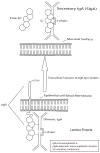Food fight! Parenteral nutrition, enteral stimulation and gut-derived mucosal immunity
- PMID: 18521625
- PMCID: PMC2739933
- DOI: 10.1007/s00423-008-0339-x
Food fight! Parenteral nutrition, enteral stimulation and gut-derived mucosal immunity
Abstract
Introduction: Nutrition support is an integral component of modern patient care. Type and route of nutritional support impacts clinical infectious outcomes in critically injured patients.
Discussion: This article reviews the relationships between type and route of nutrition and gut-derived mucosal immunity in both the clinical and laboratory settings.
Figures







Similar articles
-
[The immune system of the gastrointestinal tract].Leber Magen Darm. 1986 Mar;16(2):93-103. Leber Magen Darm. 1986. PMID: 3713420 German. No abstract available.
-
Is there evidence that the gut contributes to mucosal immunity in humans?JPEN J Parenter Enteral Nutr. 2007 May-Jun;31(3):246-58. doi: 10.1177/0148607107031003246. JPEN J Parenter Enteral Nutr. 2007. PMID: 17463152 Review.
-
Effects of adding butyric acid to PN on gut-associated lymphoid tissue and mucosal immunoglobulin A levels.JPEN J Parenter Enteral Nutr. 2011 Jul;35(4):465-72. doi: 10.1177/0148607110387610. Epub 2011 Apr 5. JPEN J Parenter Enteral Nutr. 2011. PMID: 21467244
-
[The effect of aging on the intestinal immune system. Mucosal immunosenescence].Internist (Berl). 1995 Jul;36(7):648-55. Internist (Berl). 1995. PMID: 7672912 Review. German. No abstract available.
-
Reversal of parenteral nutrition-induced gut mucosal immunity impairment with small amounts of a complex enteral diet.J Trauma. 2008 Aug;65(2):360-5; discussion 366. doi: 10.1097/TA.0b013e31817c9711. J Trauma. 2008. PMID: 18695472
Cited by
-
IL-25 improves IgA levels during parenteral nutrition through the JAK-STAT pathway.Ann Surg. 2013 Dec;258(6):1065-71. doi: 10.1097/SLA.0b013e318277ea9e. Ann Surg. 2013. PMID: 23160152 Free PMC article.
-
Cranberry proanthocyanidins improve the gut mucous layer morphology and function in mice receiving elemental enteral nutrition.JPEN J Parenter Enteral Nutr. 2013 May-Jun;37(3):401-9. doi: 10.1177/0148607112463076. Epub 2012 Oct 11. JPEN J Parenter Enteral Nutr. 2013. PMID: 23064255 Free PMC article.
-
Animal models of gastrointestinal and liver diseases. Animal models of infant short bowel syndrome: translational relevance and challenges.Am J Physiol Gastrointest Liver Physiol. 2014 Dec 15;307(12):G1147-68. doi: 10.1152/ajpgi.00088.2014. Epub 2014 Oct 23. Am J Physiol Gastrointest Liver Physiol. 2014. PMID: 25342047 Free PMC article. Review.
-
B-lymphocyte-intrinsic and -extrinsic defects in secretory immunoglobulin A production in the neural crest-conditional deletion of endothelin receptor B model of Hirschsprung-associated enterocolitis.FASEB J. 2019 Jun;33(6):7615-7624. doi: 10.1096/fj.201801913R. Epub 2019 Mar 25. FASEB J. 2019. PMID: 30908942 Free PMC article.
-
Literature review and global consensus on management of acute radiation syndrome affecting nonhematopoietic organ systems.Disaster Med Public Health Prep. 2011 Oct;5(3):183-201. doi: 10.1001/dmp.2011.73. Epub 2011 Oct 10. Disaster Med Public Health Prep. 2011. PMID: 21986999 Free PMC article. Review.
References
-
- Fletcher AG, Jr, Gimbel NS, Riegel C. Parenteral nutrition with human serum albumin as the source of protein in the early post-operative period. Surg Gynecol Obstet. 1950;90:151–154. - PubMed
-
- Turner FP. Hyperalimentation in the management of pyloric obstruction with comments on certain theoretical relationships between protein deficiency and peptic ulcer. Gastroenterology. 1955;29:1061–1068. - PubMed
-
- Wretlind A. The possibilities of providing adequate parenteral nutrition. Nord Med. 1955;53:1013–1019. - PubMed
-
- McKibbin JM, Ferry RM, Stare FJ. Parenteral Nutrition. Ii the Utilization of Emulsified Fat Given Intravenously. J Clin Invest. 1946;25:679–686. - PubMed
-
- Watkin DM. Fecal Excretion of Lipids Before, during and After Hyperalimentation with Fat Administered Intravenously. Am J Clin Nutr. 1965;16:213–223. - PubMed
Publication types
MeSH terms
Substances
Grants and funding
LinkOut - more resources
Full Text Sources

